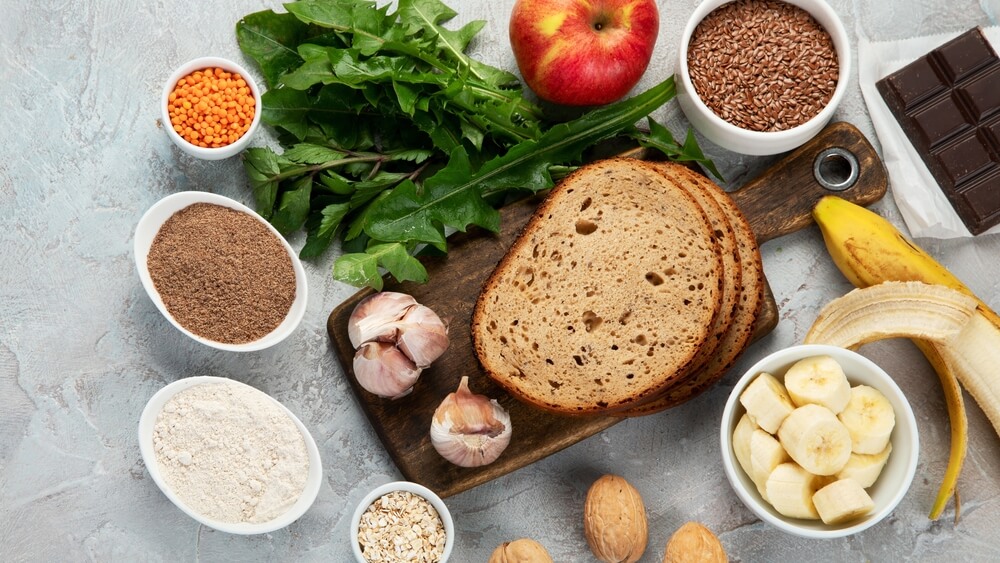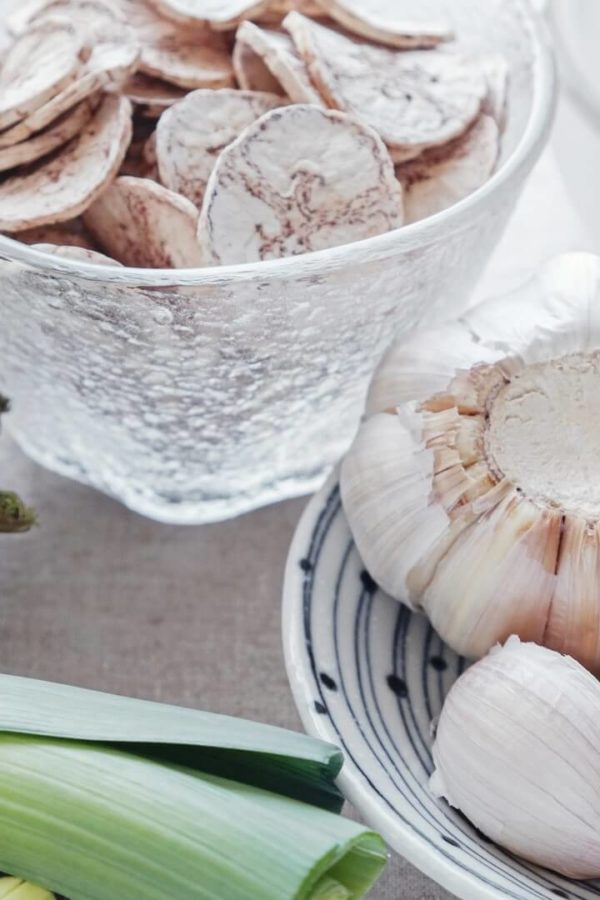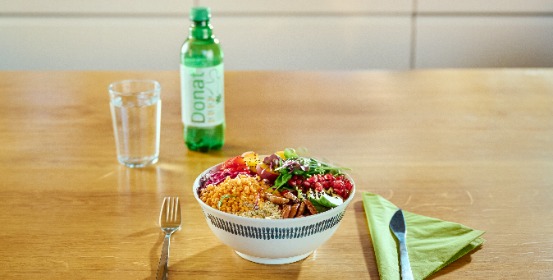You’ve probably heard that probiotics are extremely important for digestive health. But when we talk about these beneficial microorganisms, we often forget about the substances that are closely linked to them and just as important for the health of the digestive tract: prebiotics. That’s why it’s time to introduce them in more detail. Of course, we’ll also tell you the difference between probiotics and prebiotics. We promise it’s more than just one letter, so read on.
First, let’s review the basics about probiotics.
To understand the link between probiotics and prebiotics and the fundamental differences between them, we need to look at the basic facts about the gut microbiota.
A regular and healthy digestive system is more important than we might think. It’s the key to overall health. The reason is simple, yet surprising to many: the digestive tract is where 70% to 80% of the cells of the immune system are located. And it’s also home to billions of microorganisms that make up the intestinal microbiota. These include both beneficial bacteria, which help the gut to stay in balance, and harmful ones, which disrupt this balance and cause digestive problems.
You’re already familiar with bacteria which, in moderate amounts, are beneficial for overall health. They’re called probiotics, and you can read about them in the article Probiotics and Digestive Health. They can be found in fermented foods such as yoghurt, sour milk, and kefir, as well as sauerkraut or kimchi. Of course, they can also be taken in the form of food supplements.
Probiotics are involved in the final and very important phase of digestion; they protect the body against pathogens by suppressing their growth with metabolic activity; they aid in the synthesis of some B vitamins and vitamin K; and are central to the normal functioning of the body’s immune system.
The key to health lies in the balance between beneficial and harmful bacteria.
As we have already highlighted, our gut is home to both beneficial and potentially harmful bacteria. The balance between them is what determines how our digestive system functions and how healthy we are.
But this balance can be quickly disturbed by a number of factors, such as:
- stress,
- improper and unbalanced diet,
- psychophysical exhaustion,
- chronic illnesses,
- fever and
- certain medications, in particular antibiotics.
The consequence of a disturbed balance is an increase in harmful bacteria, which often leads to health issues, some of which are:
- diarrhoea,
- constipation,
- bloating,
- lack of important vitamins and minerals (due to their limited absorption in the intestine),
- weight gain and
- weakened immune system (making the body more vulnerable to various infections).
The intestinal microbiota is constantly changing, and it is up to us to replenish it by ensuring that there are enough probiotics in our gut. This is where prebiotics are crucial, as they provide food for beneficial bacteria.

So what are prebiotics?
The answer to the question of the difference between probiotics and prebiotics is therefore clear. In short: probiotics are the bacteria that are good for the intestines, and prebiotics are the food that feeds them. But let’s look into this a little further.
Prebiotics are indigestible parts of plant foods (carbohydrates) – commonly sourced from Jerusalem artichokes (a plant with a tuber similar to a potato) and chicory. They help us by providing nutrients for the beneficial bacteria in our intestines, so that they outnumber the potentially harmful ones. They have the following three effects:
- promoting the growth of healthy bacteria,
- increasing the multiplication rate of microorganisms in the gut, and
- boosting the activity of existing healthy bacteria.
A diet rich in prebiotic foods can contribute significantly to the healthy balance between beneficial and harmful intestinal bacteria, and in turn support a healthy body.
Which prebiotics do we know about?
Inulin and oligofructose are two of the most studied prebiotics. Numerous laboratory studies have demonstrated their beneficial effects on the balance of intestinal microbiota. Inulin and oligofructose promote the growth of lactobacilli and bifidobacteria, which have been proven to have a number of benefits for the body. Various strains of bifidobacteria and lactobacilli are among the probiotics most commonly added to food. There are other prebiotic substances in addition to inulin and oligofructose.
Prebiotics are also added to fermented dairy products to improve the survival rate of probiotics. They can also serve as a replacement for sugar and fat. Another of their advantages is the low glycaemic index value, which makes them suitable for diabetic patients.
Which foods contain prebiotics?
Both prebiotics and probiotics can be found in the food we eat. Natural prebiotics are present in many everyday foods, so there’s often no need for dietary supplements. One excellent and very popular source of prebiotics is chicory root, which tastes similar to coffee, yet contains no caffeine. Let’s take a look at some of the other great sources of prebiotics.
- Onions and garlic are not only tasty additions to many dishes, but also act as prebiotics. Some studies have shown that they stimulate the growth of beneficial bifidobacteria in the intestine, thereby also inhibiting the production of harmful bacteria.
- Barley and oats contain beta-glucans. There are a number of studies on beta-glucans, some of which have shown that they promote the growth of lactobacilli, which are highly beneficial probiotics.
- Unripe (green) bananas are also the subject of many studies. They are high in so-called resistant starch, whose prebiotic effect has been scientifically proven.
Natural prebiotics are also present in:
- wholemeal bread,
- corn,
- blueberries,
- cherries and
- asparagus.

For a healthy digestive system, consume probiotics and prebiotics
If you’re suffering from indigestion or want to regulate your intestinal microbiota, there are a number of things you can do:
- Use foods rich in probiotics or probiotic supplements to enrich your gut with healthy bacteria.
- Use prebiotics to help the existing bacteria in your gut to proliferate and create a healthy balance.
- Consume probiotics and prebiotics together. This way you introduce more healthy microorganisms into the gut and ensure that the prebiotics strengthen both the existing and newly introduced beneficial bacteria. And this is how you can achieve the best results for your own health.
Frequently asked questions
1. What are prebiotics?
Prebiotics are indigestible food components that feed the good bacteria in our intestines and enable them to outnumber the potentially harmful ones.
2. Why are prebiotics so useful?
Our gut microflora keeps changing. It consists of useful and harmful bacteria, and our health depends on the right balance between them. Prebiotics feed the healthy bacteria and thereby make sure that they outnumber the harmful ones, providing balance in our intestines.
3. Which factors disturb the balance of our gut microflora?
There are numerous factors that can disturb this balance, such as stress, irregular and imbalanced diet, psycho-physical fatigue, chronic diseases, and high body temperature. It is also important to mention the use of medications, especially antibiotics.
4. What are the consequences of disturbed balance in the gut microflora?
The most common consequences of disturbed balance in the gut microflora are diarrhea, constipation, bloating, and a weakened immune system due to a lack of vitamins and minerals that cannot be absorbed in the intestines.
5. In which foodstuffs can prebiotics be found?
An important source of prebiotics is, for example, chicory root, onion, garlic, and oatmeal.
Choose chapter:






